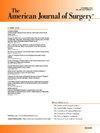Postoperative outcomes in super- and super-super obese patients undergoing emergency abdominal surgery
IF 2.7
3区 医学
Q1 SURGERY
引用次数: 0
Abstract
With a rising prevalence of Class III obesity (BMI ≥40), it is crucial to identify the perioperative risks associated with super-obesity (BMI 50–59.9) and super-super-obesity (BMI ≥60) in patients undergoing emergency general surgery procedures. The American College of Surgeons National Surgery Quality Improvement Program (NSQIP) database was queried for emergency abdominal surgeries between January 1, 2015 and December 31, 2019. 19,205 patients aged ≥18 years with a BMI ≥40 were included and stratified into morbidly obese, super-obese, and super-super-obese categories.
The 30-day mortality rate in the super-super-obese group (7.2%) was significantly higher than the morbidly obese (4.1%) and super-obese (5.4%) groups. Compared to morbidly obese patients, super-obese and super-super-obese patients had significantly higher odds for septic shock and reoperation. Super-super-obese patients additionally had significantly higher odds for readmission.
These findings suggest that super- and super-super-obese patients warrant tailored perioperative management and separate risk considerations.
接受紧急腹部手术的超级和超级肥胖患者的术后结局
随着III类肥胖(BMI≥40)患病率的上升,在接受紧急普通外科手术的患者中,识别与超级肥胖(BMI 50-59.9)和超级超级肥胖(BMI≥60)相关的围手术期风险至关重要。在美国外科医师学会国家手术质量改进计划(NSQIP)数据库中查询2015年1月1日至2019年12月31日期间的急诊腹部手术。19205例年龄≥18岁、BMI≥40的患者被纳入研究,并被分为病态肥胖、超肥胖和超超肥胖三类。超超肥胖组30天死亡率(7.2%)显著高于病态肥胖组(4.1%)和超肥胖组(5.4%)。与病态肥胖患者相比,超肥胖和超超肥胖患者发生感染性休克和再手术的几率明显高于病态肥胖患者。此外,超级肥胖患者再入院的几率也明显更高。这些发现表明,超级和超级肥胖患者需要量身定制的围手术期管理和单独的风险考虑。
本文章由计算机程序翻译,如有差异,请以英文原文为准。
求助全文
约1分钟内获得全文
求助全文
来源期刊
CiteScore
5.00
自引率
6.70%
发文量
570
审稿时长
56 days
期刊介绍:
The American Journal of Surgery® is a peer-reviewed journal designed for the general surgeon who performs abdominal, cancer, vascular, head and neck, breast, colorectal, and other forms of surgery. AJS is the official journal of 7 major surgical societies* and publishes their official papers as well as independently submitted clinical studies, editorials, reviews, brief reports, correspondence and book reviews.

 求助内容:
求助内容: 应助结果提醒方式:
应助结果提醒方式:


